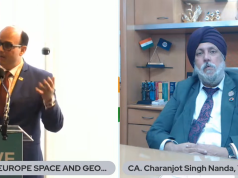 Now that President Donald Trump signed into law a set of new sanctions against Russia on Wednesday, and Moscow retaliated by ordering America to cut its diplomatic and technical staffs, the space community is worried that it could have repercussions on the bilateral ties between the two countries on space activities.
Now that President Donald Trump signed into law a set of new sanctions against Russia on Wednesday, and Moscow retaliated by ordering America to cut its diplomatic and technical staffs, the space community is worried that it could have repercussions on the bilateral ties between the two countries on space activities.
Though the Bill — Countering America’s Adversaries Through Sanctions Act — carefully mentions it will not affect any activities of NASA, there are enough noises from Moscow that they may retaliate in a manner that could adversely affect the existing space ties.
Among other things, any adverse moves by Russia may leave US without any access to the International Space Station since at present only the Russian vehicles are capable of making manned launches. Ever since the US Space Shuttle program ended in 2011, Soyuz rockets have become the only provider of transport for astronauts at the space station.
That’s a weak point and the Russians know that too. As Nikolay Platoshkin, a former Russian diplomat and professor at the Moscow University of the Humanities, was quoted by Russian media last week following the passage of the Bill by the Senate: “The text of the bill itself contains a tip. It’s in section 237 which reads that the measures included in this act should not impede the activities of NASA. So, let’s cut them off from space. Russia may stop transporting American astronauts to the ISS. May they take a horse.”
In the single largest forced reduction in embassy staff ordered by President Putin last week following the passage of the Bill by Senate — comparable only to the closing of the American diplomatic presence in the months following the Communist revolution in 1917 – US diplomatic missions in Moscow and elsewhere in Russia have been ordered to reduce their staffs by 755 people. According to Washington Post, NASA has only 12 employees in Russia right now – eight Americans and four foreign nationals.
It’s not just launches, US is dependent on Russia’s propellant module to keep the ISS in orbit.
What does the Bill say?
The Bill very specifically mentions the “exceptions relating to activities of the National Aeronautics and Space Administration” and that “this Act and the amendments made by this Act shall not apply with respect to activities of the National Aeronautics and Space Administration”.

According some space experts, including Keith Cowling, the editor of the popular blog NASAWatch, by explicitly mentioning that NASA and space activities are specifically exempted from being part of any sanctions that might be imposed upon Russia, US has inadvertently given Russia a list of things that are vital, upsetting which could damage American interests.
The Russian space agency Roscosmos reportedly charges $81 million per seat for rides to the ISS, a tag that has been a sore point with US Congress for some time now. NASA’s Commercial Crew Program is working with Boeing and SpaceX in an effort to end the nation’s sole reliance on Russia for access to space. Initially targeted for 2015, and then 2017, it looks neither Boeing nor SpaceX will be in a position before 2019 to launch humans into space.
History of US-Russian space ties
The US-Russian space partnership has long endured the political tensions for years now. At the height of the Cold War in 1975, an American Apollo and Russian Soyuz capsule had docked together in orbit.

However, it wasn’t since the end of the Cold War that the two countries worked hard to build their partnership in space. The International Space Station project was the first significant collaborative effort since the end of the Cold War. The first module of the ISS, Zarya, was launched on November 20, 1998 on an autonomous Russian Proton rocket. This was followed by a passive NASA module Unity, launch two weeks later aboard the Space Shuttle flight STS-88 and attached to Zarya by astronauts during EVAs. The first resident crew, Expedition 1, comprising two Russians and one American, arrived in November 2000 on a Soyuz TM-31, and has been staffed with astronauts from various countries participating in the mission for almost 17 years now, making ISS the longest continuous human presence in low earth orbit.
The ISS is divided into two sections — the Russian Orbital Segment (ROS) and the United States Orbital Segment (USOS). The American portion of ISS is being funded until 2024; Roscosmos has endorsed the continued operation of ISS through 2024 but has proposed using elements of the Russian Orbital Segment to construct a new Russian space station called OPSEK.
The 2014 Ukraine crisis
It may be mentioned that this is not the first time political developments have threatened to encroach into space. Back in 2014, when the US had imposed similar sanctions in Russia over its actions in Ukraine, there were largescale apprehensions about a big fallout, especially when Obama administration put Dmitry Rogozin, then Russian Deputy Prime Minister for Space and Defense, on the sanctions list. Moscow retaliated by announcing that it would stop selling the RD-180 engine to the US for military payloads. The RD-180 is used by United Launch Alliance (ULA) – the partnership between Boeing and Lockheed Martin — which produces the Atlas V launch system that carries US military and commercial satellites into orbit. US finally blinked when ULA couldn’t find a replacement for the RD-180.
On April 5 this year, Roscosmos chief Igor Komarov said at the US Space Symposium in Colorado that Russia was open to extending its partnership in the ISS with the US, Europe, Japan and Canada beyond the currently planned end of the program in 2024. “We appreciate that … political problems do not touch this sphere,” Komarov said.
But for how long? That’s a tough question.







Comments are closed.